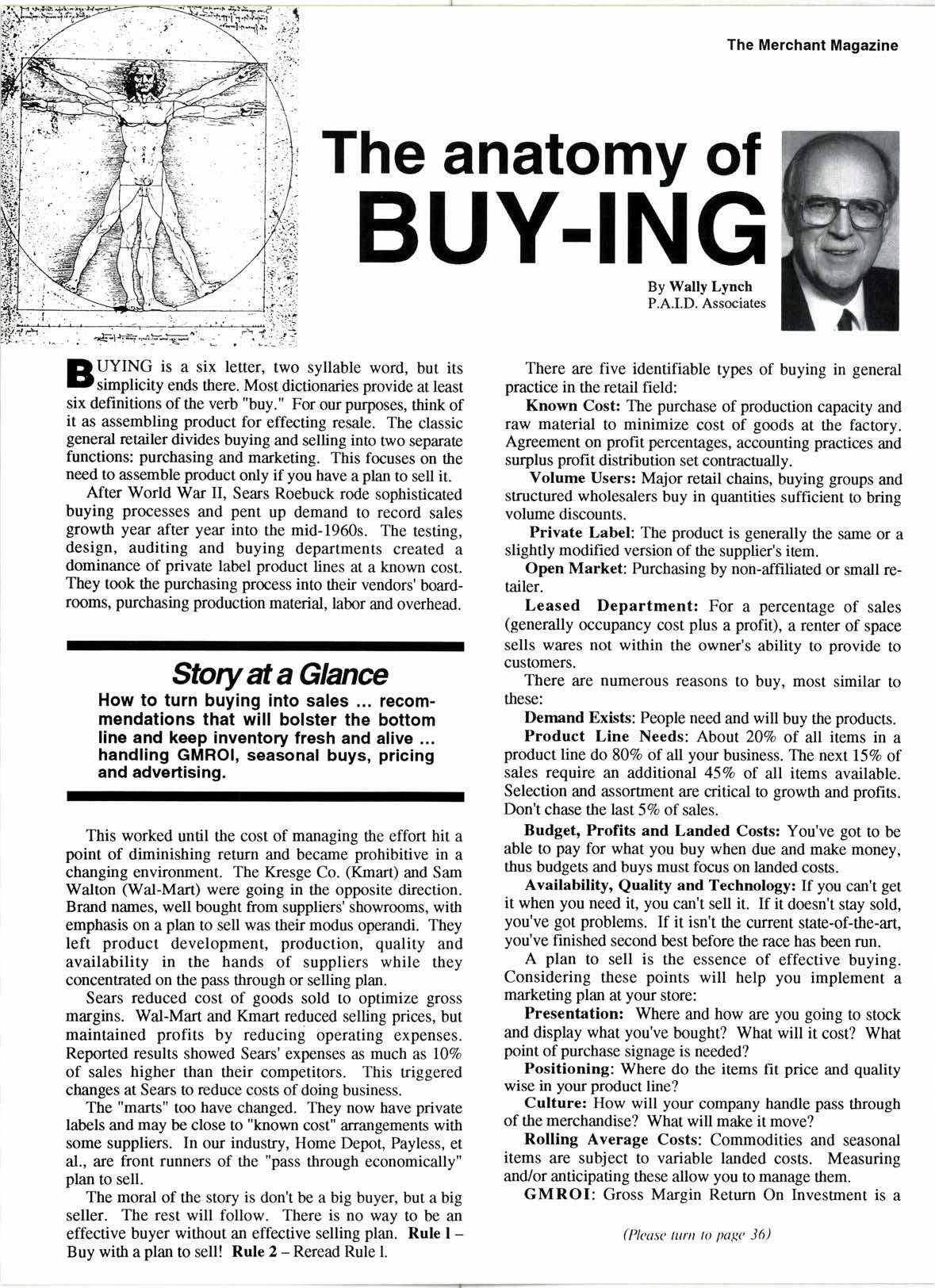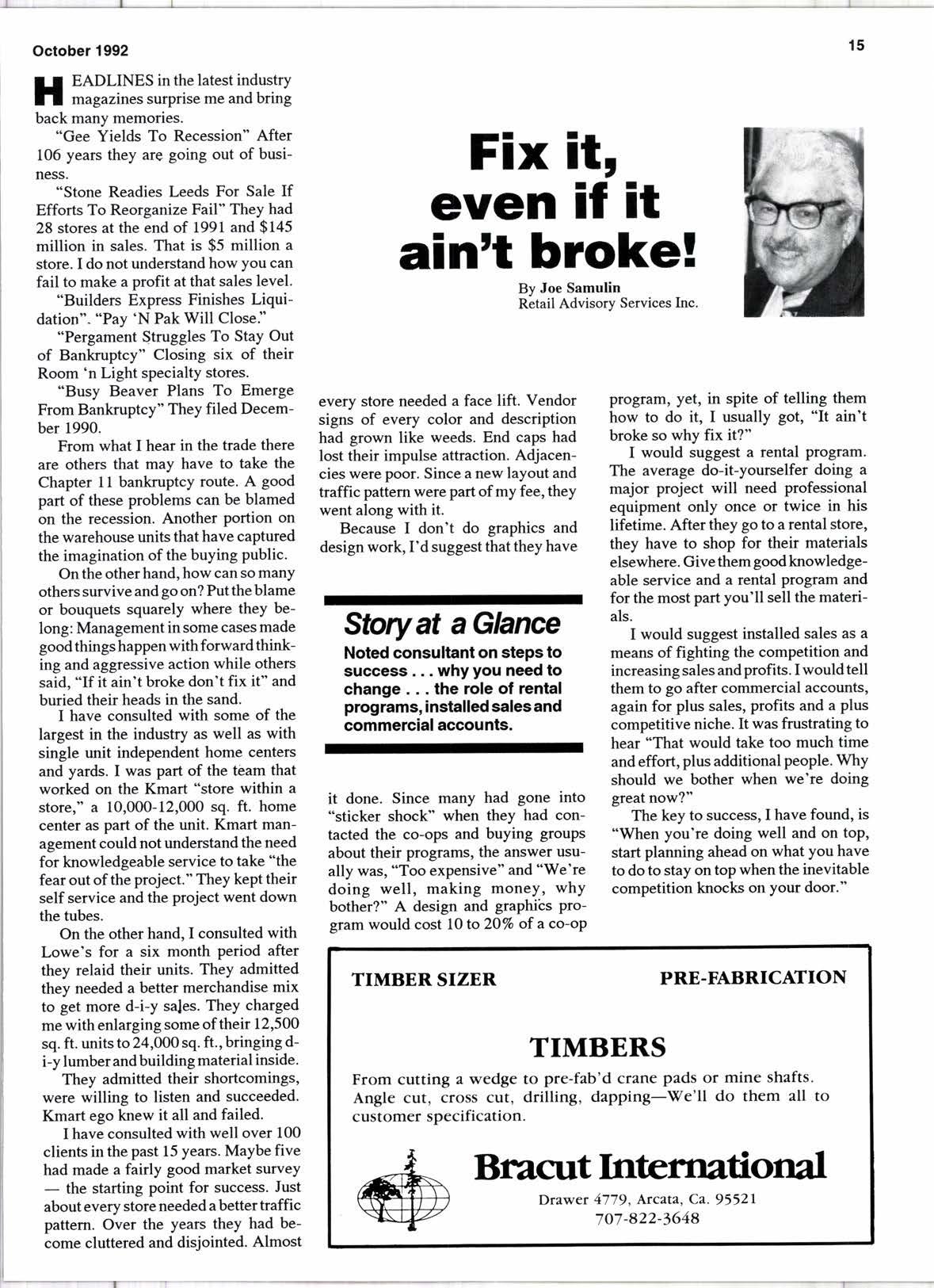
4 minute read
The anatomy of BUY. ING
By Wally Lynch P.A.I.D. Associates
RUYING is a six letter, two syllable word, but its Esimplisily ends there. Most dictionaries provide at least six definitions of the verb "buy." For our purposes, think of it as assembling product for effecting resale. The classic general retailer divides buying and selling into two separate functions: purchasing and marketing. This focuses on the need to assemble product only if you have a plan to sell it.
After World War II, Sears Roebuck rode sophisticated buying processes and pent up demand to record sales growth year after year into the mid-1960s. The testing, design, auditing and buying departments created a dominance of private label product lines at a known cost. They took the purchasing process into their vendors'boardrooms, purchasing production material, labor and overhead.
Story at a Glane
How to turn buying into sales ... recommendations that will bolster the bottom line and keep inventory fresh and alive handling GMROI, seasonal buys, pricing and advertising.
This worked until the cost of managing the effort hit a point of diminishing return and became prohibitive in a changing environment. The Kresge Co. (Kmart) and Sam Walton (Wal-Maft) were going in the opposite direction. Brand names, well bought from suppliers'showrooms, with emphasis on a plan to sell was their modus operandi. They left product development, production, quality and availability in the hands of suppliers while they concentrated on the pass through or selling plan.
Sears reduced cost of goods sold to optimize gross margins. Wal-Mart and Kmart reduced selling prices, but maintained profits by reducing operating expenses. Reported results showed Sears'expenses as much as llVo of sales higher than their competitors. This triggered changes at Sears to reduce costs ofdoing business.
The "marts" too have changed. They now have private labels and may be close to "lnown cost" iurangements with some suppliers. In our industry, Home Depot, Payless, et al., are front runners of the "pass through economically" plan to sell.
The moral of the story is don't be a big buyer, but a big seller. The rest will follow. There is no way to be an effective buyer without an effective selling plan. Rule lBuy with a plan to sell! Rule 2 - Reread Rule l.
There are five identifiable types of buying in general practice in the retail field:
Known Cost The purchase of production capacity and raw material to minimize cost of goods at the factory. Agreement on profit percenrages, accounting practices and surplus profit distribution set contractually.
Volume Users: Major retail chains, buying groups and structured wholesalers buy in quantities sufficient to bring volume discounts.
Private Label: The product is generally the same or a slightly modified version of the supplier's item.
Open Market: Purchasing by non-affiliated or small retailer.
Leased Department: For a percentage of sales (generally occupancy cost plus a profit), a renter of space sells wares not within the owner's ability to provide to customers.
There are numerous reasons to buy, most similar to these:
Demand Exists: People need and will buy the products.
Product Line Needs: About 207o of all items in a product line do 80Vo of all your business. The next l57o of sales require an additional 45Vo of all items available. Selection and assortment are oitical to growth and profis. Don't chase the last 57o of sales.
Budget, Profits and Landed Costs: You've got to be able to pay for what you buy when due and make money, thus budgets and buys must focus on landed costs.
Availability, Quality and Technology: If you can't get it when you need it, you can't sell it. If it doesn't stay sold, you've got problems. If it isn't the current state-of-the-art, you've finished second best before the race has been run.
A plan to sell is the essence of effective buying. Considering these points will help you implement a marketing plan at your store:
Presentation: Where and how are you going to stock and display what you've bought? What will it cost? What point of purchase signage is needed?
Positioning: Where do the items fit price and quality wise in your product line?
Culture: How will your company handle pass through of the merchandise? What will make it move?
Rolling Average Costs: Commodities and seasonal items are subject to variable landed costs. Measuring and/or anticipating these allow you to ruilrage them.
GMROI: Gross Margin Return On Invesonent is a
(Please turn to page 36)
IJ EADLINES inthelatestindustry E magazines surprise me and bring back many memories.
"Gee Yields To Recession" After 106 years they are going out of business.
"Stone Readies Leeds For Sale If Efforts To Reorganize Fail" They had 28 stores at the end of 1991 and $145 million in sales. That is $5 million a store. I do not understand how you can fail to make a profit at that sales level.
"Builders Express Finishes Liquidation". "Pay 'N Pak Will Close."
"Pergament $truggles To StaY Out of Bankruptcy" Closing six of their Room 'n Light specialty stores.
"Busy Beaver Plans To Emerge From Bankruptcy" They filed December 1990.

From what I hear in the trade there are others that may have to take the Chapter 11 bankruptcy route. A good part of these problems can be blamed on the recession. Another portion on the warehouse units that have captured the imagination of the buying public.
On the other hand, how can so many others survive and go on? Put the blame or bouquets squarely where they belong: Management in some cases made good thingshappen withforward thinking and aggressive action while others said, "lf it ain't broke don't fix it" and buried their heads in the sand.
I have consulted with some of the largest in the industry as well as with single unit independent home centers and yards. I was part of the tbam that worked on the Kmart "store within a store," a 10,000-12,000 sq. ft. home center as part of the unit. Kmart management could not understand the need for knowledgeable service to take "the fear out ofthe project." They kept their self service and the project went down the tubes.
On the other hand, I consulted with Lowe's for a six month period after they relaid their units. They admitted they needed a better merchandise mix to get more d-i-y sales. They charged me with enlarging some of their 12,500 sq. ft. units to 24,0fi) sq. ft., bringing diy lumber and building material inside.
They admitted their shortcomings, were willing to listen and succeeded. Kmart ego knew it all and failed.
I have consulted with well over 100 clients in the past 15 years. Maybe five had made a fairly good market surveythe starting point for success. Just about every store needed a better traffic pattern. Over the years they had become cluttered and disjointed. Almost










